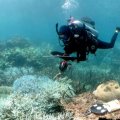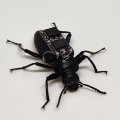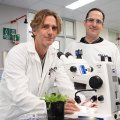While Brisbane experienced a record heat wave last month, The University of Queensland was one of the coldest places in the universe.
UQ physicists led by research fellow Dr Chris Vale and Professor Halina Rubinsztein-Dunlop produced the coldest known substance, cooling atoms to almost absolute zero (-273.15 Celsius) on February 20.
They have achieved a new state of matter known as a Bose-Einstein condensate, or BEC for short.
“We succeeded in cooling a sample of 20,000 rubidium atoms to a temperature just 100 billionths of a degree above absolute zero, or 0.0000001 degrees Kelvin," Dr Vale said.
“When certain atoms get this cold they form a BEC. There have been several BECs made in laboratories around the world, including one in Canberra and one in New Zealand.
“The UQ experiment, however, is one of only a handful in the world, and the first in the southern hemisphere, created on an atom chip.”
Dr Vale said traditional BEC experiments had provided many valuable insights but were not suitable for making devices.
“This is the reason why Australia`s newest BEC in Brisbane is so significant,” he said.
“The atom chip is a circuit of microscopic wires very similar to computer chips, and is a lot smaller than traditional experiments.
“These could form the basis for future quantum technologies. However, there are many fundamental questions to be answered beforehand.”
The breakthrough, funded as part of a five-year, $1.4 million Australian Research Council Discovery Program grant, was conducted in UQ`s Atom Optics lab using an atom trapping and cooling apparatus and associated laser equipment. It follows many years of painstaking work.
UQ has one of the largest centres for atom optics research in the southern hemisphere, with 20 researchers and postgraduates pursuing projects in the field. It is one of the nation`s hot-spots for BEC research.
Theoretician Dr Matthew Davis said that due to their ultra cold temperature, BECs were extremely fragile objects and had to be completely isolated from their surroundings.
“Their existence lies deep in the heart of the theory of quantum mechanics, and physicist Albert Einstein was the first to predict the phenomenon in 1924.
“However, for many decades BECs remained a theoretical curiosity — no one could possibly imagine that they could be seen on Earth as the conditions required were so extreme.”
Rapid advances in cooling atoms using lasers and magnetic fields in the 1990s led to the first observation of a Bose condensate in 1995 in Boulder, Colorado, USA. Since this time there has been an explosion of interest in this field. The significance of the achievement was recognised when the 2001 Nobel Prize in Physics was awarded to the researchers who led the way to Bose-Einstein condensation.
Dr Davis said Bose-Einstein condensates had very special properties.
“When atoms are sufficiently cold, quantum mechanics tells us that instead of acting as point-like particles they begin to behave as waves,”he said.
“In a BEC all of the atoms combine in the same ‘wave’, forming a gigantic wave of matter - the atoms ‘sing together in unison’. They lose their individual identities and behave as though they are a single superatom.
“The atoms in a BEC also share many of the special properties of light from a laser.”
Professor Rubinsztein-Dunlop said BECS were a ‘dream come true’ for physicists.
“The theory of quantum mechanics has been incredibly successful over the past 80 years, as yet having never been proven wrong,” she said.
“However, many people, including Einstein, have been deeply unhappy with some of its philosophical implications, and some believe that it is not the full description of nature.
“BECs are one of the largest and purest objects ever made that still require quantum mechanics to explain their properties, and so they offer another realm in which the theory can be tested, and perhaps even proved incomplete.
“Also, there is the potential for technological applications of BECs. Lasers have been used in many different ways, but one of the most important is in improving the accuracy of precision measurements.
“They are an essential component of technology such as the Global Positioning System (GPS), which requires accurate time keeping with atomic clocks. Atom lasers, made by extracting a beam of atoms from a BEC, may lead to far superior scientific measurement than can be achieved with ordinary lasers.”
The UQ research team is now planning to study the dynamic properties of such systems, and look at the transition from the everyday classical world to the quantum realm. They are also developing techniques to investigate how individual atoms behave inside a condensate.
Media: For further information, contact: Dr Chris Vale telephone 07 3346 9425, Dr Matthew Davis 07 3365 3420 or visit: http://www.physics.uq.edu.au/atomoptics
or http://www.acqao.org
For images of the researchers and the formation of the Bose-Einstein condensate contact UQ photolibrary coordinator Diana Lilley 07 3365 2753.
.jpg)



